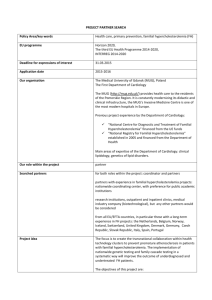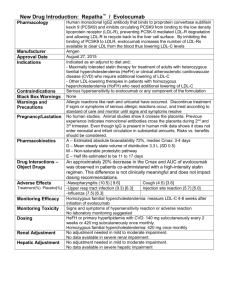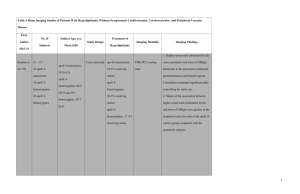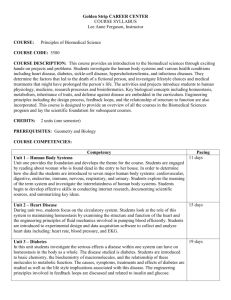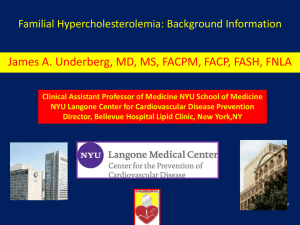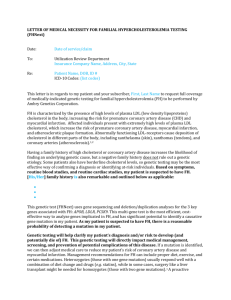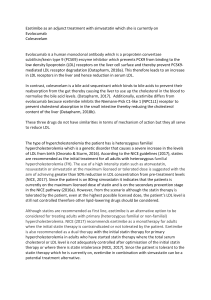Genetics Project2
advertisement
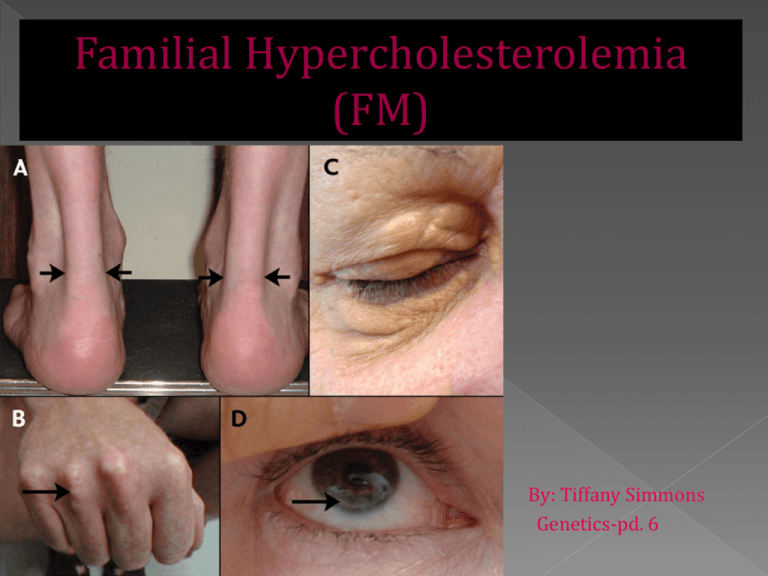
Familial Hypercholesterolemia (FM) By: Tiffany Simmons Genetics-pd. 6 Hypercholesterolemia is just another way of saying that a person has a high level of bad cholesterol. Familial Hypercholesterolemia is when this high level of bad cholesterol is passed down through the family. This is usually detected once the baby is born. This condition can also cause early age heart attacks Having “bad” levels of high cholesterol is also having a low density of lipoprotein (LDL) Lipoprotein or LDL is a type of protein, having to much lipoprotein in the blood system can cause the clogging of arteries. Type II hyperlipoproteinemia; Hypercholesterolemic xanthomatosis; Low density lipoprotein receptor mutation Hypercholesterolemia has the word Familial in front of it because this disease is passed down through the genes of the parents. Hypercholesterolemia can first occur by there being a defect on chromosome 19. This defect does not allow the body to remove LDL cholesterol from the body, therefore causing the body to have extremely high amounts of LDL Since chromosome 19 is defected it makes Familial Hypercholesterolemia a chromosomal mutation. Familial Hypercholesterolemia can absolutely be passed down to future generations. It can be passed down in what is called an autosomal dominant manner. Autosomal dominant means that only one parent has to have the gene in order for any of the offspring to get it. In extremely rare cases both parents can have this abnormal chromosome and the child gets the gene from both parents. This would be a more severe case of familial hypercholesterolemia and the child would have an even higher risk of having heart disease or heart attack. The phenotypic effects of familial hypercholesterolemia can be pretty bad. One effect is xanthoma. This is when fat builds up under the surface of the skin. Another effect is xanthelasmas is the same thing as xanthoma, but around your eyelid. When a doctor notices high levels of LDL or sees any xanthomas then he would run a few tests and diagnose the patient with familial hypercholesterolemia or not. The doctor will also check the family background to see any early histories of heart attacks or heart diseases. To treat Familial hypercholesterolemia patients usually have to revise how they eat. A healthy diet of non fatty foods and plenty of exercise will help to reduce the LDL levels in the blood significantly. Reducing fat and reducing cholesterol is the key to make LDL levels a lot more safer. To reduce fat ear less beef, pork, and lamb Choosing low-fat dairy products Avoiding coconut and palm oil By not eating Egg yolks Organ meats Sources of animal-derived saturated fat will reduce cholesterol Usually patients that have only received one mutated gene from one parent will be fine with the diet and exercise. Any other patients who have received the gene from both of their parents will have a nit of a tougher time getting their LDL levels to be at a safe amount http://emedicine.medscape.com/article/121298-overview http://rarediseases.info.nih.gov/GARD/Disease.aspx?PageID=4&diseas eID=10416 http://ghr.nlm.nih.gov/condition=hypercholesterolemia http://adam.about.com/encyclopedia/infectiousdiseases/Familialhypercholesterolemia.htm http://www.nlm.nih.gov/medlineplus/ency/article/000392.htm http://www.umm.edu/ency/article/000392.htm http://www.genome.gov/25520184.
